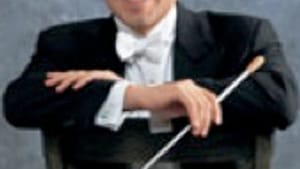Stay in the Loop
BSR publishes on a weekly schedule, with an email newsletter every Wednesday and Thursday morning. There’s no paywall, and subscribing is always free.
Orchestra's "Night of the Mayas'

The Orchestra's Mayan tour de force
LEWIS WHITTINGTON
Palpable energy floated through the Verizon Hall audience at the Philadelphia Orchestra’s “Night of the Mayas” concert. The Peruvian conductor Miguel Harth-Bedoya, current music director of the Fort Worth Symphony, also conducts operas, and some of that grand scope was certainly apparent in the symphonic coloratura.
Night of the Mayas— composed by Silvestre Revueltas for Chano Urueta’s 1939 film of the same name— explores themes of ancient Mayan civilization fused with contemporary symphonia. Even without actual visuals, Mayas is an epic narrative, as if we’re flying over and swooping in on action scenes.
The rhythm matrices of regional instruments evoke everything from a bongo cool samba to a brutal ancient sacrificial dance. Serene environs are carved out by the full orchestra; mysterious rustles of flora and fauna are disturbed by the attacking beast of a horn section. And then there’s a conk shell fanfare that ignites a symphonic mix of epic proportions during the “Night of the Yucatan.” This is a fabulous tour de force for and by the orchestra, triumphantly piloted by Harth-Bedoya.
Harth-Bedoya opened the evening tentatively, coaxing the orchestra to blooming templates in Maurice Ravel’s Rapsodie Espagnole. It took a while for the some of Ravel’s cathartic lushness to emerge out of the orchestra’s studied tightness. Muscling violin exchanges floating through the spiraling density in the back half seemed to open it up. The Feria (final) movement engulfed the hall.
Pianist Markus Groh is the embodiment of 19th-Century romanticism, with his angular countenance and enough actual long hair to remind us that “long hair music” once meant something other than rock. His was the perfectly sly style for the virtuosic treacle laced in Franz Liszt‘s Piano Concerto No. 1. Groh’s introductory passages were intense interplays between soloist and orchestra that seemed emotionally rote, but by the time Groh settled into the spidery keyboard runs, relying less on lush melancholia, a more relevant (and sturdier) romanticism emerged.
The interior dimensions given Ravel’s Bolero were not nearly as exciting as Night of the Mayas. This isn’t really a piece that lends itself to exploration, and so is best left alone. Its ascension from a whispered one to ten was interestingly amped by the conductor— he started at three, ultimately grinding to ten. Bolero’s galleon kettle and cadet drum spine makes for a droning forward march. Its snaking oboes and clarinets should hypnotize enough so one is unaware of the progressions. Harth-Bedoya’s reading tangled it up with anticipated gearshifts and accents that sapped its primal power. That hardly mattered on this night, because it was played lustily and received by the lustily cheering audience.
LEWIS WHITTINGTON
Palpable energy floated through the Verizon Hall audience at the Philadelphia Orchestra’s “Night of the Mayas” concert. The Peruvian conductor Miguel Harth-Bedoya, current music director of the Fort Worth Symphony, also conducts operas, and some of that grand scope was certainly apparent in the symphonic coloratura.
Night of the Mayas— composed by Silvestre Revueltas for Chano Urueta’s 1939 film of the same name— explores themes of ancient Mayan civilization fused with contemporary symphonia. Even without actual visuals, Mayas is an epic narrative, as if we’re flying over and swooping in on action scenes.
The rhythm matrices of regional instruments evoke everything from a bongo cool samba to a brutal ancient sacrificial dance. Serene environs are carved out by the full orchestra; mysterious rustles of flora and fauna are disturbed by the attacking beast of a horn section. And then there’s a conk shell fanfare that ignites a symphonic mix of epic proportions during the “Night of the Yucatan.” This is a fabulous tour de force for and by the orchestra, triumphantly piloted by Harth-Bedoya.
Harth-Bedoya opened the evening tentatively, coaxing the orchestra to blooming templates in Maurice Ravel’s Rapsodie Espagnole. It took a while for the some of Ravel’s cathartic lushness to emerge out of the orchestra’s studied tightness. Muscling violin exchanges floating through the spiraling density in the back half seemed to open it up. The Feria (final) movement engulfed the hall.
Pianist Markus Groh is the embodiment of 19th-Century romanticism, with his angular countenance and enough actual long hair to remind us that “long hair music” once meant something other than rock. His was the perfectly sly style for the virtuosic treacle laced in Franz Liszt‘s Piano Concerto No. 1. Groh’s introductory passages were intense interplays between soloist and orchestra that seemed emotionally rote, but by the time Groh settled into the spidery keyboard runs, relying less on lush melancholia, a more relevant (and sturdier) romanticism emerged.
The interior dimensions given Ravel’s Bolero were not nearly as exciting as Night of the Mayas. This isn’t really a piece that lends itself to exploration, and so is best left alone. Its ascension from a whispered one to ten was interestingly amped by the conductor— he started at three, ultimately grinding to ten. Bolero’s galleon kettle and cadet drum spine makes for a droning forward march. Its snaking oboes and clarinets should hypnotize enough so one is unaware of the progressions. Harth-Bedoya’s reading tangled it up with anticipated gearshifts and accents that sapped its primal power. That hardly mattered on this night, because it was played lustily and received by the lustily cheering audience.
Sign up for our newsletter
All of the week's new articles, all in one place. Sign up for the free weekly BSR newsletters, and don't miss a conversation.
